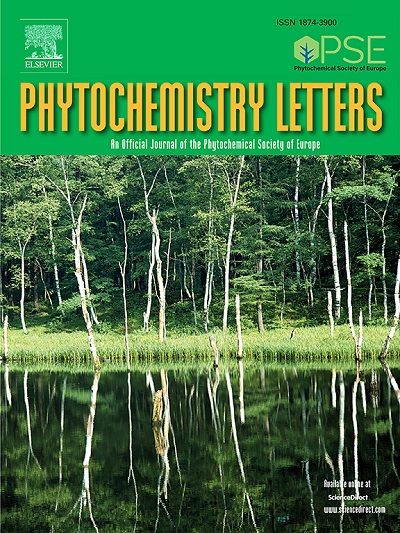紫花番荔枝生物碱诱导作用的研究。& sess ex Dunal Curvularia lunata (Wakker) Boedijn和stolonifer Ehrenb。(前)林德。
IF 1.4
4区 生物学
Q4 CHEMISTRY, MEDICINAL
引用次数: 0
摘要
番荔枝(Annona purpurea)是番荔枝科的一种,可合成50多种生物碱,其中大部分具有苯基异喹啉结构。一些生物碱具有防御功能,从生态学的角度可以分为组成代谢物和诱导代谢物。诱导代谢物的表达是对触发植物胁迫的非生物或生物条件变化的响应。很少有研究将生物碱生产作为生物胁迫的功能。研究了紫荆幼苗生物碱代谢对月曲霉和匍匐茎霉侵染的响应。采用气相色谱-质谱联用技术,从对照和染病幼苗的叶片、茎和根中提取甲醇提取物,测定其生物碱谱。化学多样性是通过Margalef、Shannon和Simpson的适应生态指数和器官特异性丰度确定的。此外,还进行了主成分分析(PCA)、PERMANOVA和配对PERMANOVA。结果表明,月牙草对其有诱导反应,尤其是匍匐茎。结果表明,幼苗有一个有效的生物碱库,其中一些根据感染的植物病原体作出反应。本文章由计算机程序翻译,如有差异,请以英文原文为准。
Alkaloid induction by the interaction between Annona purpurea Moc. & Sessé ex Dunal Curvularia lunata (Wakker) Boedijn and Rhizopus stolonifer Ehrenb. (Ex Fr.) Lind.
Annona purpurea is a species of the Annonaceae family that biosynthesizes more than 50 alkaloids, most of them with benzylisoquinoline structure. Some alkaloids perform defense functions and can be grouped from the ecological perspective as constitutive and induced metabolites. Induced metabolites are expressed in response to changes in abiotic or biotic conditions that trigger plant stress. Few studies have been conducted on alkaloid production as a function of biotic stress. In this work, the response of the alkaloid metabolism of A. purpurea seedlings to infection with fungi Curvularia lunata and Rhizopus stolonifer was analyzed. To determine the alkaloid profile, methanolic extracts were obtained from leaves, stems and roots of control and infected seedlings, which were analyzed by Gas Chromatography coupled to Mass Spectrometry. Chemical diversity was determined by the presence and organ-specific abundance and by means of the adapted ecological indices of Margalef, Shannon and Simpson. In addition, Principal Component Analysis (PCA), PERMANOVA and paired PERMANOVA were performed. Induced responses with C. lunata and especially with R. stolonifer were found. Results indicate that seedlings have an arsenal of available alkaloids, some of which respond according to the infecting phytopathogen.
求助全文
通过发布文献求助,成功后即可免费获取论文全文。
去求助
来源期刊

Phytochemistry Letters
生物-生化与分子生物学
CiteScore
3.00
自引率
11.80%
发文量
190
审稿时长
34 days
期刊介绍:
Phytochemistry Letters invites rapid communications on all aspects of natural product research including:
• Structural elucidation of natural products
• Analytical evaluation of herbal medicines
• Clinical efficacy, safety and pharmacovigilance of herbal medicines
• Natural product biosynthesis
• Natural product synthesis and chemical modification
• Natural product metabolism
• Chemical ecology
• Biotechnology
• Bioassay-guided isolation
• Pharmacognosy
• Pharmacology of natural products
• Metabolomics
• Ethnobotany and traditional usage
• Genetics of natural products
Manuscripts that detail the isolation of just one new compound are not substantial enough to be sent out of review and are out of scope. Furthermore, where pharmacology has been performed on one new compound to increase the amount of novel data, the pharmacology must be substantial and/or related to the medicinal use of the producing organism.
 求助内容:
求助内容: 应助结果提醒方式:
应助结果提醒方式:


